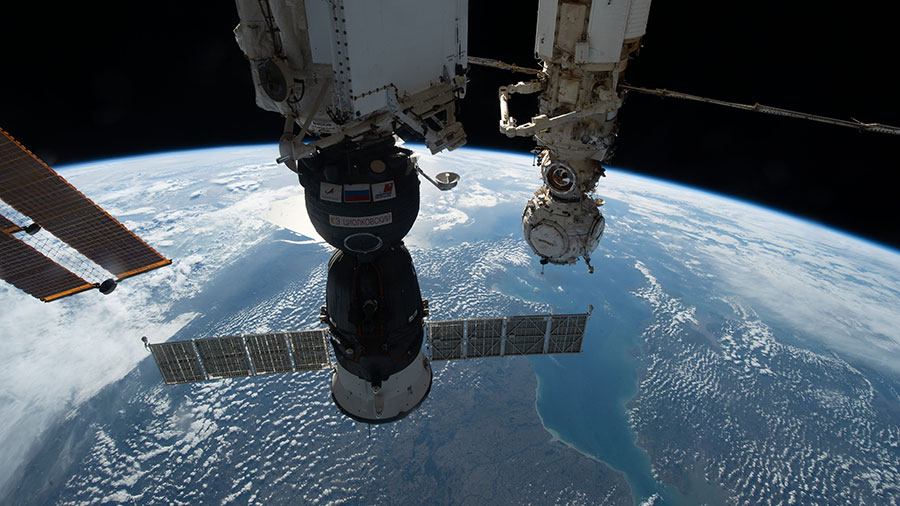Week Begins with Bone Research, Cargo Operations Ahead of Spacewalk

Life science and cargo operations kicked off the week for the Expedition 68 crew aboard the International Space Station. Two astronauts are also planning to exit the orbiting lab on Wednesday for a seven-hour spacewalk.
NASA Flight Engineers Josh Cassada and Nicole Mann took turns with Japan Aerospace Exploration Agency (JAXA) Flight Engineer Koichi Wakata on Monday servicing research samples for an experiment exploring how bones heal in space. The investigation may provide insights into debilitating bone conditions helping advance bone healing therapies for patients on and off the Earth.
All three astronauts also partnered with NASA Flight Engineer Frank Rubio and worked throughout Monday inside the Northrop Grumman Cygnus space freighter attached to the Earth-facing port of the Unity module. The quartet rotated in and out of the vehicle unpacking cargo including crew supplies, new science experiments, and station hardware, as well as stowing trash and old gear inside the space freighter for disposal.
Rubio then spent the afternoon installing multi-layer insulation inside the Harmony module’s space-facing international docking adapter to which the SpaceX Dragon resupply ship is docked. Wakata started his day preparing samples for an experiment run inside the Materials Science Laboratory, a space physics research device sponsored by ESA (European Space Agency). Mann photographed a student-designed study that is exploring new methods to degrade plastic waste in space.
Cassada and Rubio are planning to go on their third spacewalk together at 7:45 a.m. EST on Wednesday. The pair will install another roll-out solar array, also known as an International Space Station Roll-Out Solar Array (iROSA), on the space station’s truss structure. This time the duo will maneuver to the opposite side of the truss structure and install the station’s fourth iROSA on the Port-4 truss structure. The pair will spend about seven hours on the installation job live on NASA TV on the agency’s app and its website.
NASA and Roscosmos continue to evaluate an external cooling loop leak from the Soyuz MS-22 spacecraft docked to the Rassvet module of the International Space Station. Temperatures and humidity within the Soyuz spacecraft remain within acceptable limits. Roscosmos has identified the source of the leak as the external cooling loop of the Soyuz.
As part of the ongoing evaluation and investigation, a robotic inspection of the suspected leak area was completed Dec. 18, using cameras on the Canadarm2 robotic arm. A small hole was observed, and the surface of the radiator around the hole showed discoloration. Roscosmos is evaluating the imagery to determine if this hole could have resulted from micrometeoroid debris or if it is one of the pre-manufactured radiator vent holes.
Space station operations and research continue while station managers and international partners collect and analyze data, and work to develop a forward course of action for the Soyuz and its crew.
With help from the cosmonauts aboard the station, Roscosmos conducted tests on additional Soyuz systems on Dec. 16, including a short demonstration of the spacecraft’s propulsion system. So far, testing has shown no additional issues.
The Soyuz MS-22 spacecraft carried NASA astronaut Frank Rubio and Roscosmos cosmonauts Sergey Prokopyev and Dmitri Petelin into space after launching from the Baikonur Cosmodrome in Kazakhstan on Sept. 21.
The leak was first detected around 7:45 p.m. EST Dec. 14, when pressure sensors in the cooling loop showed low readings. Data analysis indicates the majority of the cooling fluid had leaked out by 1:30 p.m. Dec. 15.
At the time of the leak, Prokopyev and Petelin were preparing to conduct a spacewalk. The spacewalk was postponed, so the cosmonauts did not exit the space station or become exposed to the leaking coolant.
Back inside station, Prokopyev and Petelin configured the Poisk module and its airlock to its normal status. Prokopyev later collected obsolete hardware for disposal aboard Cygnus and also tested a 3D printer. Petelin inspected cable connections and inventoried spare parts aboard the station. Flight Engineer Anna Kikina spent the morning exploring futuristic spacecraft and robotic piloting techniques then worked in the afternoon servicing an oxygen generator.
Learn more about station activities by following the space station blog, @space_station and @ISS_Research on Twitter, as well as the ISS Facebook and ISS Instagram accounts.
Get weekly video highlights at: https://roundupreads.jsc.nasa.gov/videupdate/
Get the latest from NASA delivered every week. Subscribe here: www.nasa.gov/subscribe
from Space Station https://ift.tt/zfL7WtJ
Comments
Post a Comment